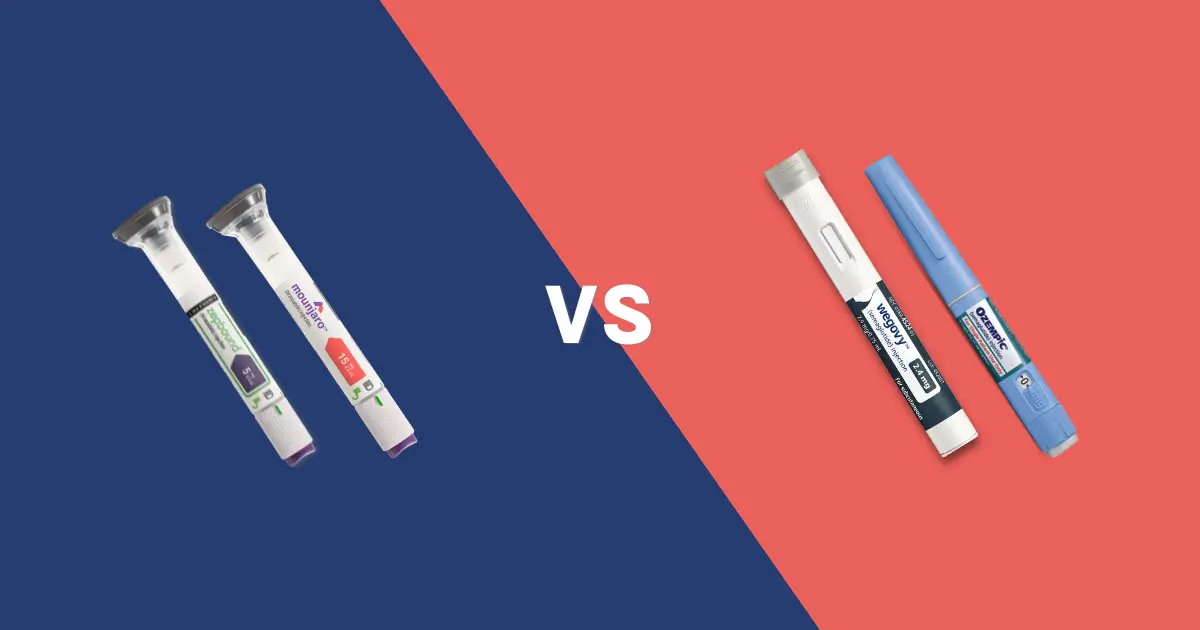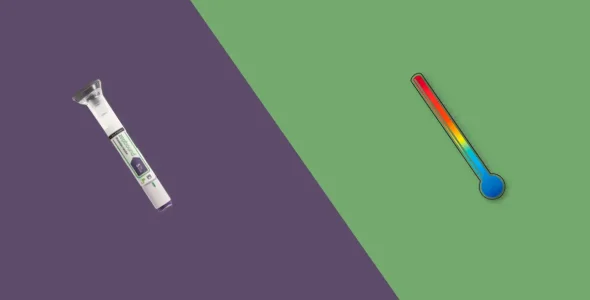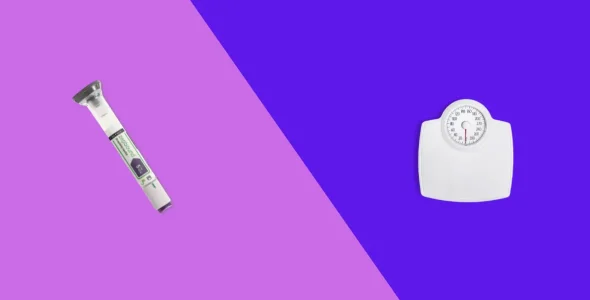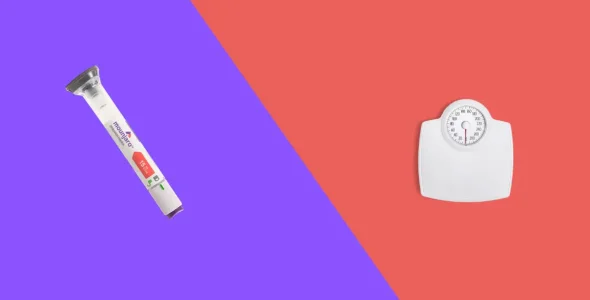Tirzepatide vs. semaglutide for weight loss compared
Key highlights
- Tirzepatide and semaglutide are once-weekly subcutaneous injectable medications approved for type 2 diabetes and chronic weight management in combination with a low-calorie diet and exercise.
- Tirzepatide's dual action on two hormone pathways may offer an additive effect, potentially leading to more significant weight loss than semaglutide. In a recent head to head, tirzepatide demonstrated superior weight loss benefits, showing 20.2% average weight loss vs. 13.7% average weight loss with semaglutide.
- Both medications offer benefits, but it is important to consider potential side effects to be fully informed about the treatment.
- If serious side effects occur, contact your doctor immediately. Do not stop taking the medication unless advised by your doctor, or if you experience a severe allergic reaction.
Semaglutide and tirzepatide are groundbreaking medications for type 2 diabetes and weight loss. In case you are wondering which medication provides superior weight loss benefits, you’ve come to the right place.
Both medications have shown significant results for controlling blood sugar levels in people with type 2 diabetes and weight loss for people with obesity or overweight. GLP-1 receptor agonists can help treat obesity and promote weight loss by slowing gastric emptying, making you feel fuller longer, and also slowing the release of glucose into your bloodstream.
Learn more about the similarities and differences of tirzepatide vs. semaglutide, including their side effects, mechanisms of action, administration, and weight loss benefits.
What is tirzepatide?
Tirzepatide, also known by the brand names Mounjaro and Zepbound, is an FDA-approved dual-action GLP-1/GIP medication made by Eli Lilly.
Zepbound (tirzepatide) is used for long-term weight management in adults with obesity (with a body mass index of 30 or higher) and overweight (with a body mass index of 27 or higher) with at least one weight-related condition, such as high blood pressure, type 2 diabetes, or high cholesterol.
Mounjaro, which also contains the same active ingredient, tirzepatide, was FDA-approved in 2022, for managing blood sugar levels in adults with type 2 diabetes. Tirzepatide has shown a significant reduction in HbA1c levels, a key measurement that reflects blood glucose levels over 3 months.
Tirzepatide combines both GLP-1 and glucose-dependent insulintropic polypeptide (GIP). The dual-action is known to make tirzepatide highly effective at controlling blood sugar levels and promoting weight loss.
Studies have also shown that tirzepatide provides improvements in people with obstructive sleep apnea.
What is semaglutide?
Semaglutide, also known by the brand names Ozempic, Rybelsus and Wegovy, is an FDA-approved once-weekly GLP-1 receptor agonist manufactured by Novo Nordisk.
Wegovy (semaglutide) is prescribed for long-term weight management in individuals who are obese (with a body mass index of 30 or higher) or overweight (with a body mass index of 27 or higher) with at least one weight-related conditions such as cardiovascular disease, high blood pressure, or type 2 diabetes.
Ozempic, which also contains the same active ingredient, semaglutide, was FDA-approved in 2017 for controlling blood sugar levels in adults with type 2 diabetes. Semaglutide has been shown in clinical trials to significantly lower HbA1c levels, an essential marker of long term blood sugar control.
Rybelsus, which also contains semaglutide, was the first oral GLP-1 medication FDA-approved in 2019 for adults with type 2 diabetes.
Studies have shown that semaglutide provides cardiovascular benefits that reduce the risk of cardiovascular events such as stroke and heart attack.
Ozempic and Rybelsus are not FDA-approved for weight loss.
Tirzepatide vs semaglutide side effects
Tirzepatide and semaglutide are both safe and effective medications used for weight loss and managing type 2 diabetes, but they can cause similar gastrointestinal side effects. Common side effects of both drugs include nausea, vomiting, diarrhea, stomach pain, and decreased appetite.
Tirzepatide may also cause additional stomach issues such as constipation, belching, indigestion, and fatigue, and there is a possible risk of low blood sugar, especially when combined with other diabetes medications.
Semaglutide can lead to constipation and carries a similar risk of low blood sugar when taken with other diabetes drugs. In rare cases, it may cause dizziness and headaches.
It is essential to be aware of these potential side effects and seek medical advice from your healthcare provider if you notice any concerning symptoms.
Tirzepatide side effects
- Nausea
- Vomiting
- Diarrhea
- Stomach pain
- Decreased appetite
- Risk of low blood sugar
Semaglutide side effects
- Nausea
- Vomiting
- Diarrhea
- Stomach pain
- Constipation
- Decreased appetite
- Headache
- Indigestion
- Dizziness
- Belching
- Risk of low blood sugar
Tirzepatide vs semaglutide for weight loss
Tirzepatide and semaglutide are both groundbreaking medications proven to be effective for weight loss in individuals who are obese or overweight.
A study (SURMOUNT-1) found that patients taking tirzepatide (Zepbound) experienced greater weight loss than those using semaglutide (Wegovy).
Eli Lilly, the maker of tirzepatide, recently published results of a head-to-head trial comparing weight loss of Zepbound (tirzepatide) and Wegovy (semaglutide). The study found that tirzepatide had superior weight loss benefits compared to semaglutide, with an average weight loss of 20.2% of participants taking tirzepatide vs. an average weight loss of 13.7% of participants taking semaglutide.
Tirzepatide weight loss
Tirzepatide works by activating both glucagon-like peptide-1 (GLP-1 receptor agonists) and glucose-dependent insulinotropic polypeptide (GIP), hormones that control appetite and influence eating habits, enhancing insulin release and helping improve the amount of weight loss.
In a clinical trial with 2,519 patients, Zepbound (tirzepatide) was taken at doses 5 mg, 10 mg, and 15 mg over a 72-week period, with an additional 958 people receiving a placebo. Patients on Zepbound lost an average of 15%, 19.5%, and 20.9% of their body weight at the respective doses, compared to 3.1% average weight loss in participants who received the placebo.
Studies have shown tirzepatide can have a greater effect on weight loss and A1C levels, but higher doses are also known to be associated with more severe stomach related side effects like nausea, vomiting and diarrhea.
RELATED: How much weight can you lose on Zepbound?, How much weight can you lose on Mounjaro?
Semaglutide weight loss
Semaglutide works by targeting the GLP-1 receptor, which helps release insulin, reduce glucagon, and control appetite.
In a clinical trial over a 68-week period, participants taking Wegovy (semaglutide) had an average weight loss of 14.9%, compared to a 2.4% average weight loss in participants who received a placebo.
RELATED: How much weight can you lose on Ozempic?, How much weight can you lose on Wegovy?
Tirzepatide vs semaglutide cost
When choosing treatments like tirzepatide and semaglutide, it is important to consider their cost and availability. These factors can impact your ability to start and continue the treatment successfully.
Insurance coverage may help with costs, but it is essential to check with your insurance provider for coverage details. The list prices below are not necessarily what you will pay, as the price varies by pharmacy and insurance coverage.
Tirzepatide cost
According to Eli Lilly, the list price of a 28-day supply of Zepbound (tirzepatide) auto-injector pens is $1,059 and Mounjaro (tirzepatide) auto-injector pens is $1,069.
The actual retail price can range from $1,000 to $1,500, depending on factors like insurance coverage, eligibility for the manufacturer’s savings cards, and the pharmacy you purchase from.
Semaglutide cost
According to Novo Nordisk, the list price of a 28-day supply of Ozempic (semaglutide) auto-injector pens is $968, Wegovy (semaglutide) auto-injector pens is $1,349 and Rybelsus (semaglutide) oral tablets is $968.
The retail price of semaglutide ranges from $1,200 to $1,400 per month, but the actual cost depends on factors like the pharmacy you purchase from, insurance coverage, and eligibility for the manufacturer’s savings cards.
Tirzepatide vs semaglutide dosage
The right dosage and how to take tirzepatide and semaglutide is important for them to work well. Both medicines are given as shots under the skin once weekly using a pen-like device. They are easy to use, so you can take the injections with little pain.
The dosage regimen typically starts with the lower doses of each medication, and the dose is slowly increased every four weeks as tolerated by the patient until a maintenance dose is reached. Tirzepatide has six weekly doses, while semaglutide has five.
Tirzepatide dosage
Healthcare providers typically start patients on a low dose of tirzepatide to help the body adjust and reduce side effects. The starting dose is typically 2.5 mg once a week for 4 weeks. After four weeks, if well-tolerated by the patient, the dose can be increased gradually (5 mg, then 7.5 mg, up to a maximum of 15 mg per week). The goal is to improve blood sugar control while minimizing stomach-related side effects.
Semaglutide dosage
Healthcare providers typically start patients on a low semaglutide dosage. The starting dose is usually 0.25 mg once a week for 4 weeks. After four weeks, the dose is gradually increased to 0.5 mg, 1 mg, and 1.75mg. Depending on how the patient tolerates side effects, the dose can be increased up to 2.4 mg per week, which is the recommended maintenance dose for Wegovy.
Tirzepatide vs semaglutide mechanism of action
Tirzepatide and semaglutide are both glucagon-like peptide-1 receptor agonists, but they work a little differently. Both medications help control blood sugar and promote weight loss, but tirzepatide also targets glucose-dependent insulinotropic polypeptide (GIP), offering extra benefits for people with both diabetes and weight issues. Tirzepatide’s dual-action approach helps manage blood sugar more effectively and supports significant weight loss, making it a superior option for treating type 2 diabetes and obesity.
How tirzepatide works
Tirzepatide works by mimicking two hormones, GLP-1 and GIP receptors, that help your pancreas release more insulin. This dual action boosts insulin release, helps manage fat storage, makes you feel fuller longer, reduces appetite, and lose weight faster. It also helps with gastric emptying, slowing the time it takes for the stomach to empty, and interacts with areas in the brain that signal satiety.
How semaglutide works
Semaglutide helps manage blood sugar and support weight loss in several ways. It stimulates the pancreas to release insulin and reduces glucagon, which helps lower blood sugar. It also controls appetite by acting on the brain and slows digestion, making you feel full longer. By mimicking a hormone called GLP-1, which is naturally produced in the gut after eating, it helps lower blood sugar, reduce sugar production in the liver, and control calorie intake. When used with a healthy diet and regular exercise, semaglutide can reduce cravings aiding in weight loss.
Are tirzepatide and semaglutide safe?
Tirzepatide and semaglutide are generally safe for most people, but like any medication, they can cause side effects. Common side effects include stomach issues like nausea, vomiting, diarrhea, and constipation, especially in the beginning. These symptoms usually improve over time.
While rare, both medications can cause serious side effects such as pancreatitis, gallbladder problems, and kidney issues. Both medications have a black box warning from the FDA for the risk of thyroid C-cell tumors.
Both drugs can also cause low blood sugar, especially if you are taking other diabetes medications, so monitor your blood sugar levels regularly. Some people may have mild reactions at the injection site, like redness or irritation.
Before starting tirzepatide or semaglutide, talk to your doctor to make sure it is the right choice for you. Your doctor can help manage side effects and adjust treatment to ensure safety and effectiveness.
Long term risks
While tirzepatide and semaglutide are effective in aiding weight loss, there are some long-term risks to be aware of. Both medications may increase the risk of pancreatitis, gallbladder problems, and kidney issues.
Another consideration is that both drugs can cause hypoglycemia, especially when used with other diabetes medications. Over time, this can lead to episodes of hypoglycemia, which needs careful management.
As injectable medications, some people may experience skin reactions at the injection site, though these are usually mild and go away on their own.
It is important to regularly check in with your healthcare provider while using tirzepatide or semaglutide to monitor for any long-term risks and make adjustments to your treatment as needed.
Safety comparison
Both tirzepatide and semaglutide are generally safe for most people, but they have some baseline differences in safety.
Common side effects: Both medications can cause gastrointestinal adverse events like nausea, vomiting, diarrhea, and constipation, especially at the start of treatment. These side effects usually get better over time.
Serious risks: While rare, both drugs can cause serious side effects like pancreatitis, gallbladder problems, changes in vision, and kidney issues.
Low blood sugar (hypoglycemia): Both medications can cause low blood sugar, especially when used with other diabetes drugs. It is essential to monitor your blood sugar levels regularly.
Heart health: Early research suggests that both drugs may have some heart benefits, but more studies are needed to fully understand how they affect heart health in the long term.
Injection site reactions: Since both medications are injected, some people may experience mild reactions at the injection site, like redness or irritation, but these usually go away on their own.
Who should take these medications?
Tirzepatide and semaglutide are primarily used to help manage blood sugar levels in people with type 2 diabetes. They can also be prescribed for weight loss in individuals who are overweight or obese, particularly when diet and exercise alone have not been effective.
These medications are suitable for adults who need help controlling their blood sugar or losing weight. However, they might not be right for everyone. People with certain health conditions, like a history of pancreatitis, gallbladder disease, or severe kidney problems, may need to avoid these medications. These medications should not be taken together, or with any other GLP-1 medication.
Before starting tirzepatide or semaglutide, it is important to talk to your doctor to see if they are the right choice based on your health and treatment goals.
Controlling blood sugar levels in adults with type 2 diabetes
Tirzepatide and semaglutide are medications that help control blood sugar levels in adults with type 2 diabetes. They work by improving how your body uses insulin, a hormone that helps lower blood sugar after meals.
Tirzepatide does this by mimicking two hormones, GLP-1 and GIP, which help your pancreas release more insulin and reduce the amount of sugar your liver makes.
Semaglutide works by mimicking the hormone GLP-1 to boost insulin production and decrease sugar production in the liver.
Both medications help lower blood sugar levels effectively and can be used along with a healthy diet and exercise plan to manage type 2 diabetes. They are often recommended when other medications are not enough for your glycemic control. Your doctor will decide which one is best for you based on your current glucose levels and needs.
Chronic weight management in people with obesity or overweight
Tirzepatide and semaglutide are also used to help with long-term weight management in people who are overweight or obese (BMI 30 or higher). These medications work by reducing appetite and helping you feel fuller for longer, which can lead to eating less and losing weight.
Tirzepatide helps by mimicking two hormones (GLP-1 and GIP) that control hunger and how your body stores fat. Semaglutide works by mimicking just one hormone, GLP-1, to achieve similar effects.
When used alongside a healthy diet and regular exercise, both medications can support weight loss and help maintain a healthy weight over time.
Switching from semaglutide to tirzepatide
If you are currently using semaglutide and your doctor decides to switch you to tirzepatide, it’s usually because tirzepatide may offer better results for managing blood sugar or weight loss.
It is usually safe to switch from semaglutide to tirzepatide, and research shows that it might even help with weight loss. However, you should always make this change under your doctor’s guidance and talk to your doctor before switching medications.
Your doctor will guide you through the switch, adjusting the dose of tirzepatide based on your needs. As with any medication change, there may be some side effects or adjustments as your body gets used to the new treatment. Always keep your doctor informed of how you are feeling and attend follow-up appointments to monitor your progress.
Which one should I choose?
The choice depends on your health goals and how your body responds to the medication. Both drugs help manage blood sugar levels and support significant weight loss.
If your main goal is to improve both blood sugar control and weight loss, tirzepatide might offer additional benefits. However, if you have already been using semaglutide and it’s working well for you, there may be no need to switch.
Your decision may depend on availability as both medications are known to be in shortage. Cost may also be a concern so check with your insurance provider to find out coverage details for both medications.
Your doctor can help determine the best medication based on your health needs, past treatment responses, and other factors. Be sure to discuss your options to make the right choice.
Bottom line
Both tirzepatide and semaglutide are effective for managing type 2 diabetes and obesity, helping with weight loss, blood sugar control, and possibly heart health. Tirzepatide may offer stronger weight loss and blood sugar control because of its dual action, while semaglutide has a proven track record and is often more affordable at the lower doses.
However, weight loss results can vary based on factors like diet, exercise, stress, sleep, and other health conditions. To get the most out of either medication, it’s important to follow a healthy lifestyle with a low-calorie diet, regular exercise, and good sleep.
The best choice typically depends on your personal health goals, tolerance for side effects, availability, and insurance coverage.










